What is Single/Multi-Camera?
Nowadays there a two ways of recording particular programs whether it is a live football match or a games show. These two techniques are used for various reasons because it really depends on the type of program genre or what is actually happening in the channel itself.
Single Camera:
This method involves one camera which is used to record a scene or even the whole program. Here usually the single camera does not have a fixed position and it is frequently moved around to capture each shot individually. Also single camera editing is done after all the footage has been recorded which can be a major set back as it a company is late on a deadline it could take up an extra few days to edit to a professional standard. If a company was to use single cameras for say instance a football match they will not be able to catch all of the events that occur in a football match which will usually make it boring for the audience to watch and not be engaging. Most programs such as EastEnders, Frozen Planet ect use this method of recording for various reasons where there are advantages and disadvantages. Some of the advantages can be that it is cheaper than using more than two or more cameras. This allows the producers to save money on hiring cameras and use the money on other equipment they may need to increase quality. But the downside of using one camera is that it take 2-3 times much longer to record on episode. Also movies use the same aspect of using single cameras but in some cases they may use more than one to capture a sequence of action. Another advantage of using one single camera in order to record a program is that it is more portable and it is easier to carry around rather than actually having two or more which could also cost to travel with as it may need a separate van/4x4 to carry where costs for hiring the car may come in. Also it saves money on crew members because you are only hiring one camera man to do all the camera work which costs considerably less that hiring two or more cameramen. While using Multi-Camera they tend to use up a lot of space and usually run of the mains where single camera takes less space and you could get more tighter angles whens recording a scene and not get caught up on time moving around the the setup. Single Camera have the ability to have control over the style of the program. This is because the cameraman can focus on recording and have more control over shots where Multi-Camera usually focus on the aesthetic reasons.
Multi-Camera:
Multi-Camera is literally the complete opposite of what Single Camera is. Multi-Cameras tend to use more than one camera to capture all the action. Instead of using a single camera to move constantly to record each shot the Multi-Camera setup allows two or more camera to be in near fixed positions to capture the whole event without missing a piece of footage that may have an unexpected outcome. The advantages with the use of Multi-Camera is that it captures all aspects of the event that is happening. This allows them to get all the angles covered in an event. The use of this allows it to be edited as it it recorded which saves time in editing. The disadvantages of Multi-Camera is that they need to run directly of the mains which means it is not portable and usually to capture an event they will need more than 3 cameras which can be manually recorded by a camera man or used by a crane to get high angles of the event.
Examples of use of Single/Multi-Cameras:
Public Event:
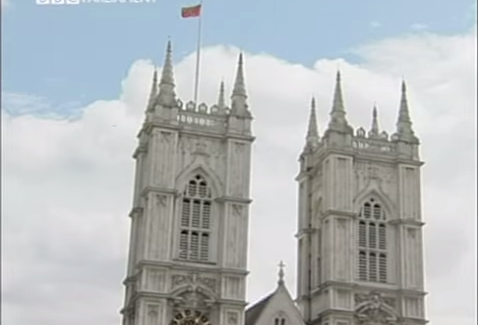 |
| Westminster Abbey Establishing Shot |
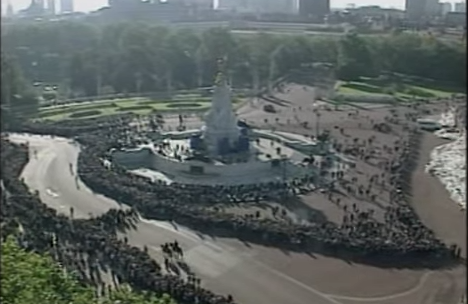 |
| Long Shot of Attended people. |
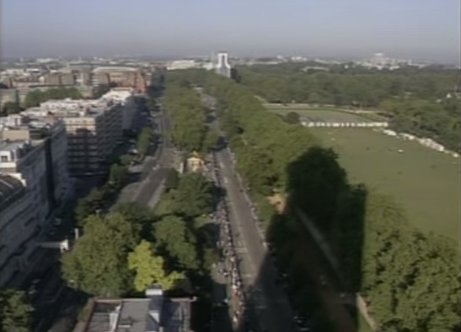 |
| The crowd waiting to see the Coffin being carried down the road. |
Here at 7:46 we see another shot of the people waiting on the side of the road to see the coffin. The use of Multi-Camera has helped a lot as it has captured the most important moments of the funeral from start till end which will allow people to remember the day she died and how her funeral was when they saw it on TV. The use of High angles shows the scale of people that were there to pay respect to Diana. By having these High / Low angles of the people who attended the funeral it shows how tragic the people felt for the death of Princess Diana. The camera Angles itself show emotions in them as well showing the event for the viewers at home.
 |
| Close Ups to show the devastation people were in. |
At 17:30 we are shown the close ups of the people who came to the funeral to show the devastation people were in towards the death of Diana. We see the people's faces who are in shock on this tragic loss. On the picture on the right we see a boy who has his head down to pay his respect to Princess Diana. If this was done with the Single Camera we would not have been able to capture these precious moments for the viewers who were watching on TV because it wouldn't have captured the most important aspects of the funeral.
With the use of Multi-Camera we are able to get a full view of the funeral while sitting at home without missing any aspects of them as each camera switches to show the movement of the coffin down London itself. Throughout the journey itself we are able to see the reactions of the residents of the UK and capture the devastated faces in detail to express how the day was very melancholic. With Multi-Camera use it has enabled us to be there without attending the actual event. The viewers are shown the whole event in angles the people who attended couldn't see in where there was establishing shots of Buckingham Palace, Westminster Abbey ect. This meant that the Multi-Camera had shown us the utmost full coverage of the event itself without missing any important factors. The Multi-Camera setup have near fixed positions which allow them to pan right/left, Zoom in and out to view the event in different viewing angles. Also the use of Multi-Cameras has an aesthetic side to it. They expressed the event in an elegant way where the shot pace was slow to express the sadness and the shots were beautifully executed to the television and Internet viewers. As they had fixed positions for the camera it had to be very important on where they placed the cameras because they would not want to miss any part of the journey through London. Also with the slow pace it allowed the cameras to capture the event in grave detail.
Live Football Match:
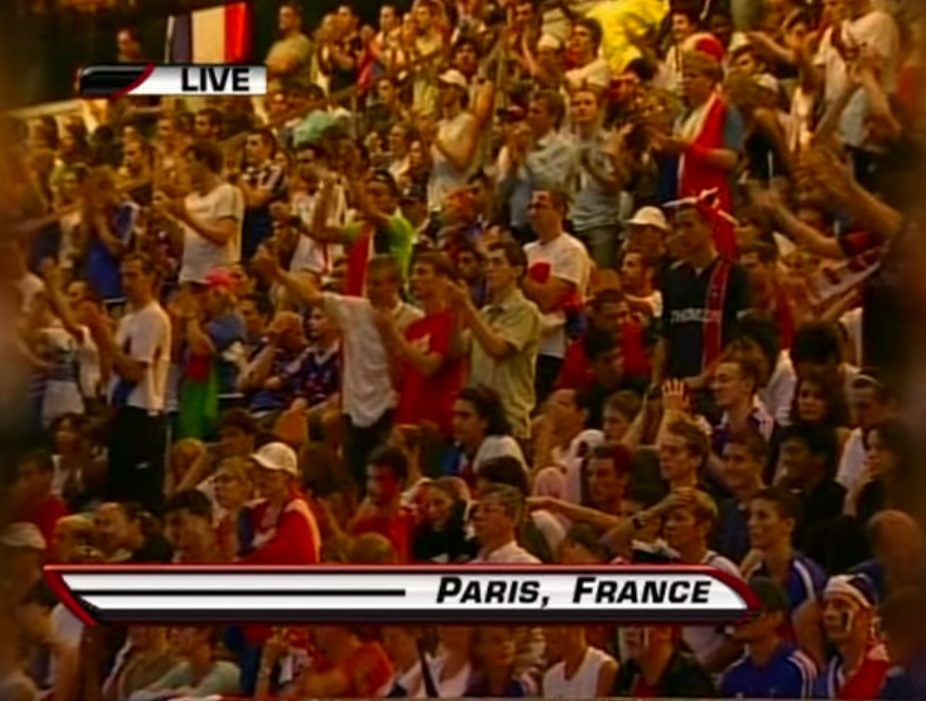 |
| Paris Supporters cheering for the referee. |
Throuhgout the football match itself it tends to be more face paced in order to the audience to enjoy the experience of viewing a football match on TV. More than 5 Shot types are used as well as therm using the cameras to pan, get closeups, Midshots ect. With that the TV Viewing experience of football will be more appealing to watch and faced paced to match the pace of the football match. At 3:33 we see the panning shot of the football players coming out of the locker rooms onto the pitch where it transitions from the locker room to the entrance of the pitch with a fade. The editing is done along with the recording so editing a 90 Minute game will be easier than ever instead of getting an editing software and rendering a 90 Minute game which would take ages.
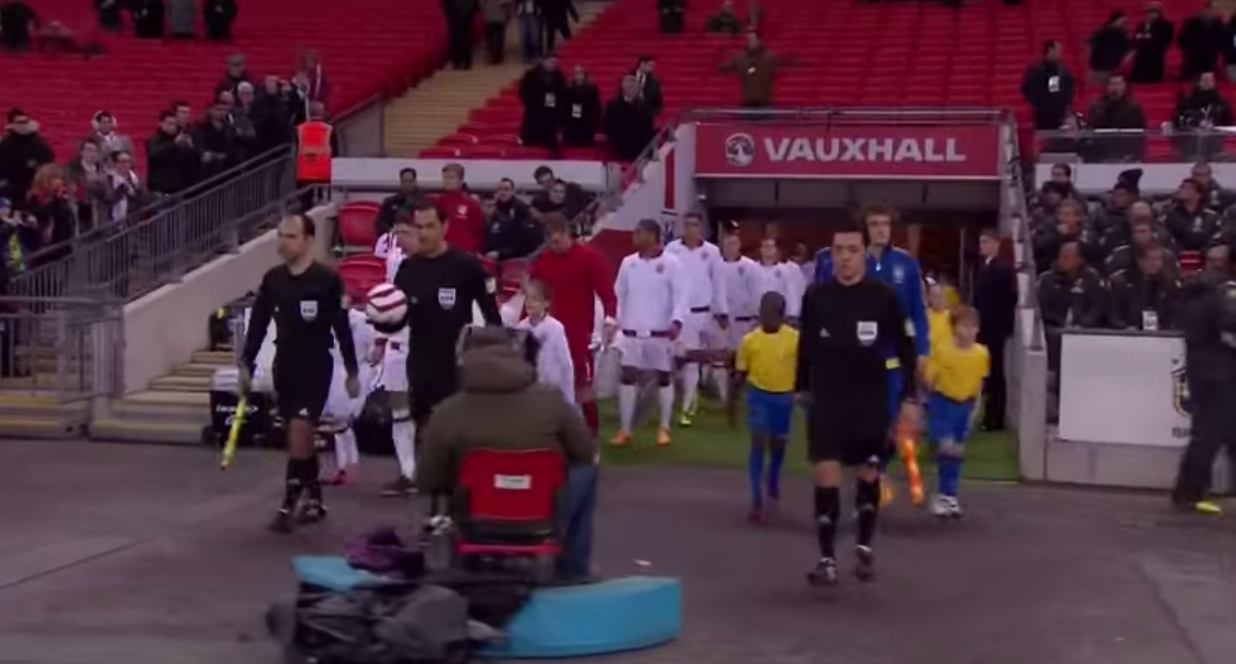 |
| 3:33 where footballers enter the PITCH. |
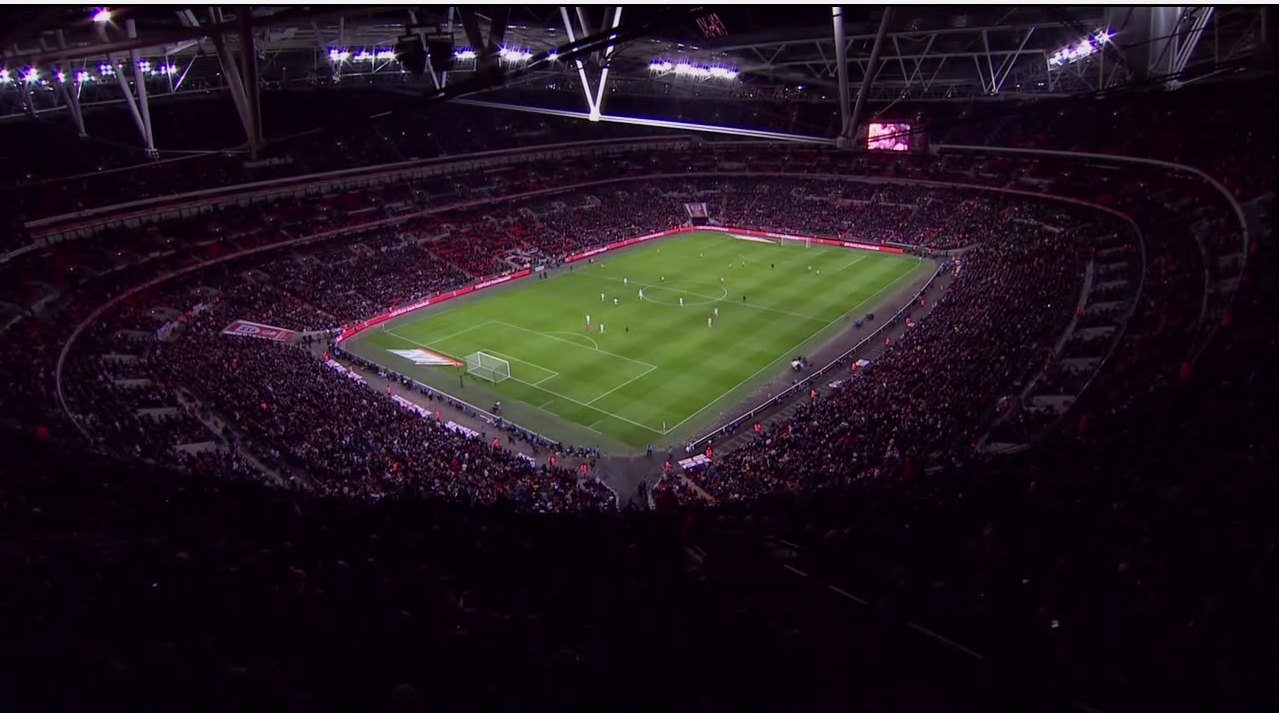 |
| Shot of the amount of people who came to watch the football match |
Around the time mark 10:45 we see a High Angle shot of the amount of people who had come in to watch the Football match and support their teams. This only could have been done with the use of the Multi Camera setup in near fixed positions because it was literally strapped to the structure of the stadium itself. This shows the astonishing amount of people who had come to watch the game to the video watchers. With Multi Cameras the TV Users get an advantage as they get to follow around the football players while they run around the pitch trying to score as if you was to be the live audience directly at the football pitch you would not be able to capture all of the viewing angles.
Game Shows:
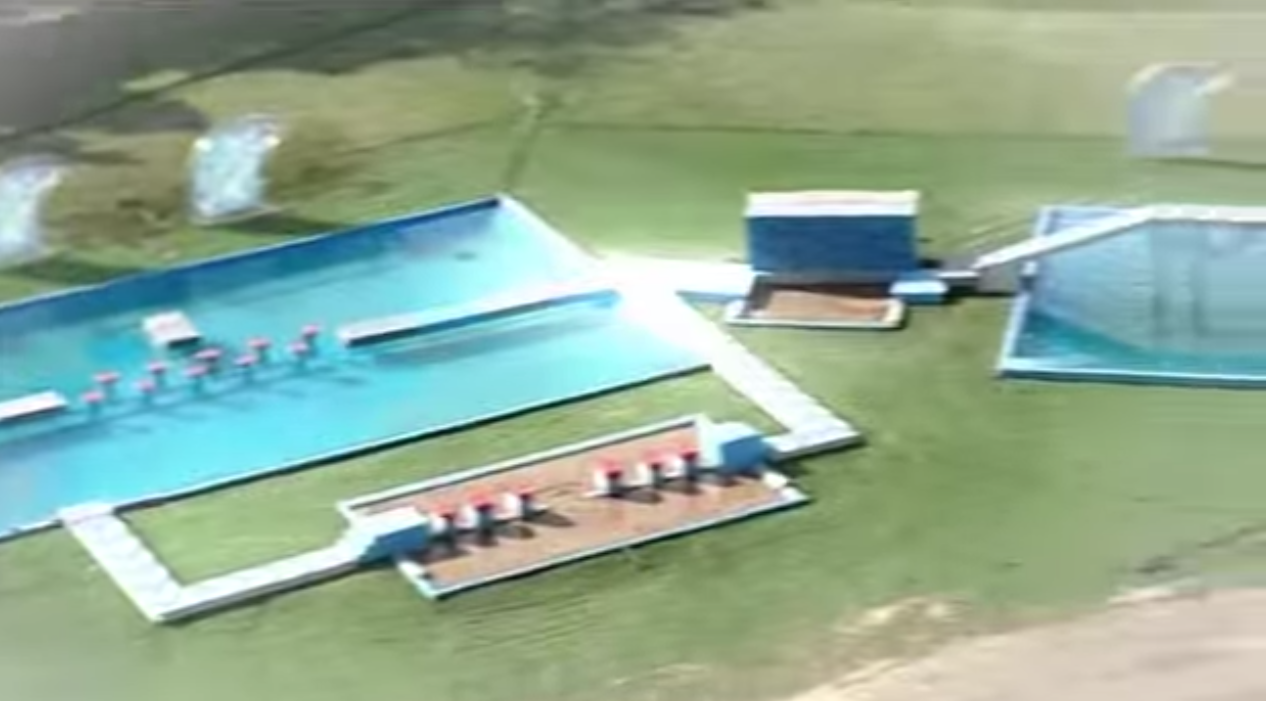 |
| Birds Eye view of the Wipeout Course |
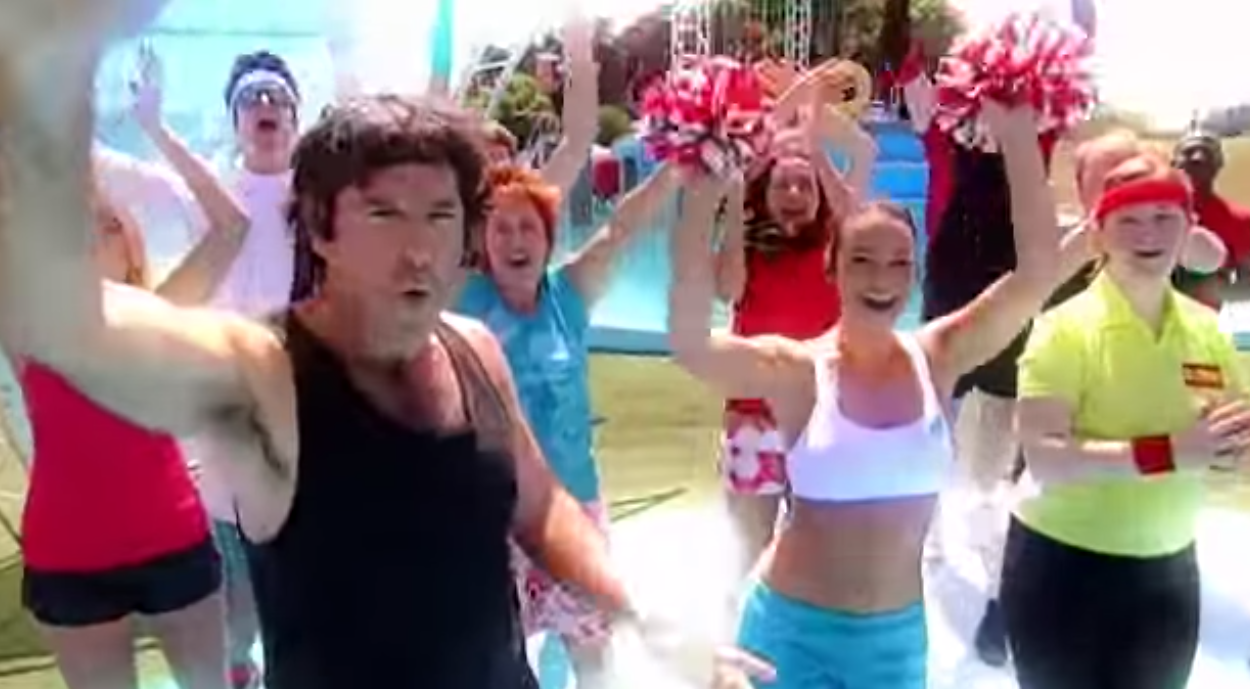 |
| View of all the Contestants |
Straight after the shot of the contestants the camera again at 0:12 pans straight up to get a full shot of all the participants dancing in joy to have the opportunity to take part in the Total Wipeout course itself in Argentina. It also shows us a glimpse of their personalities to show the audience what type of people they are whether they are serious, happy, excited. The camera's close up view allows us to show their emotions in detail for example here we see everyone very happy and they are all jumping around in joy.
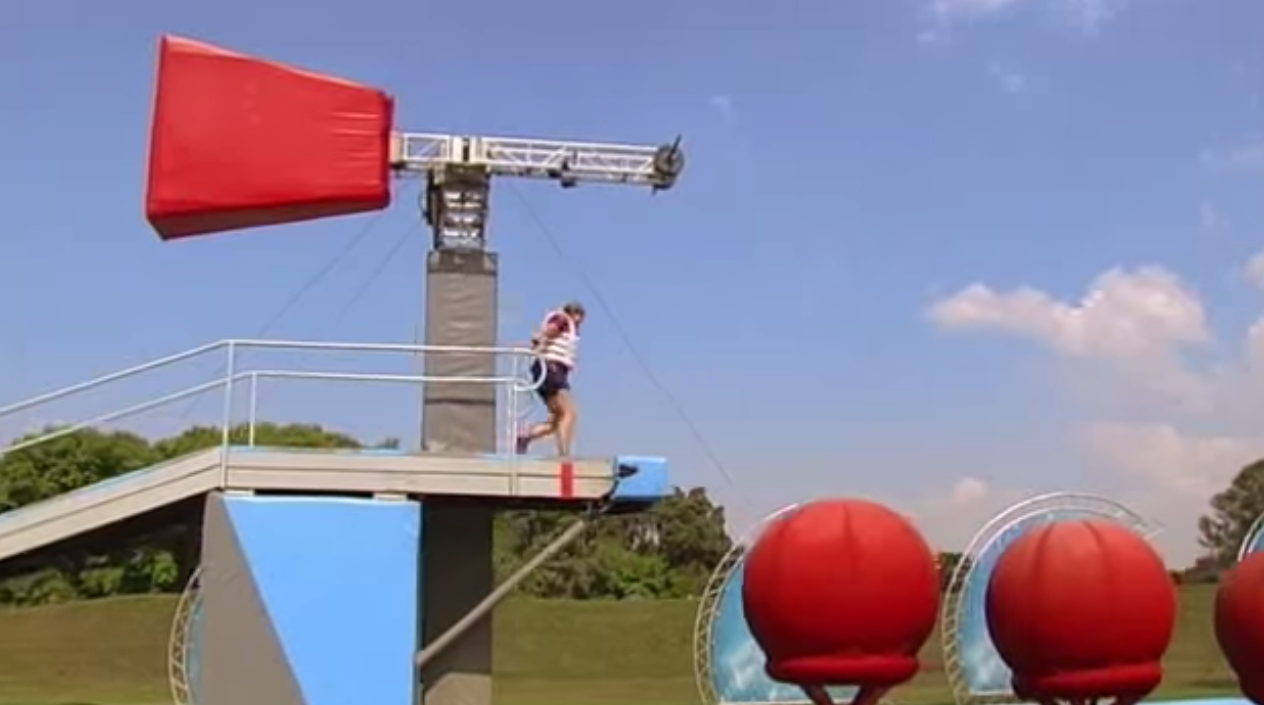 |
| Bouncy Ball Shot. |
We get a full shots of the obsticle; almost an establishing shot for the introduction of this part of the course to show the Balls and the mechanism behind her which has a few second time limit before it hits her towards the ball if she was taking long.
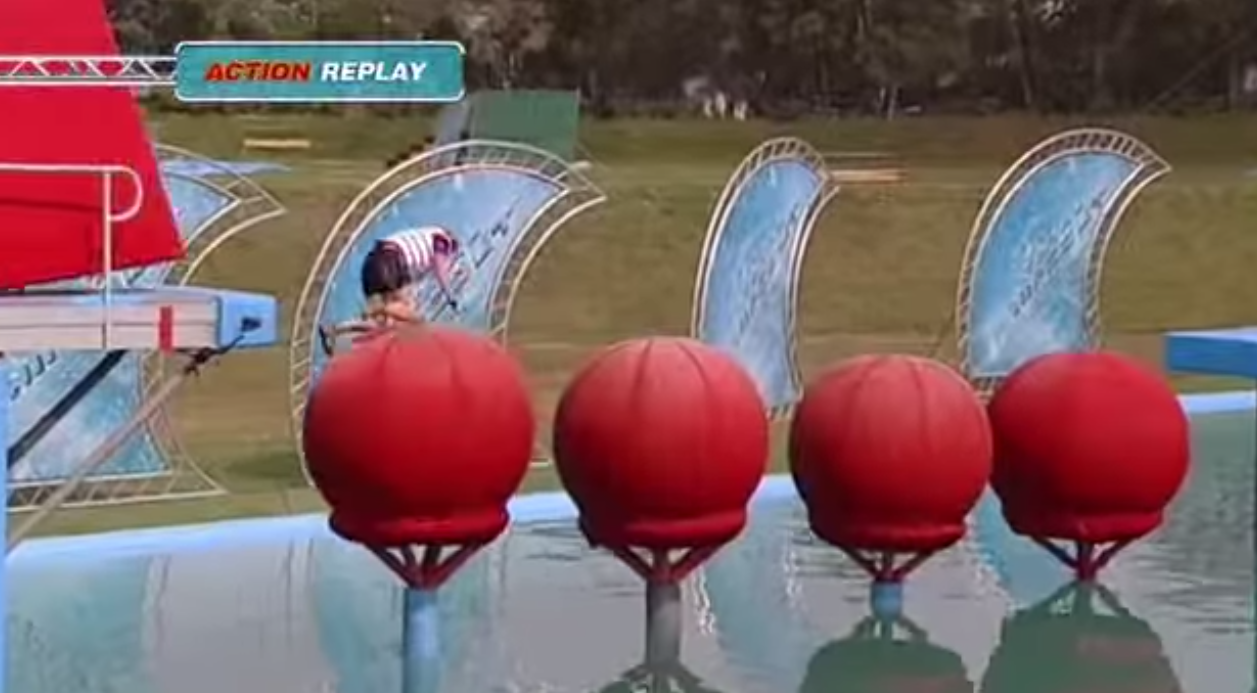 |
| Action Reply |
Here at 5:30 we see the action reply of the same obstacle. This was shown because of the Multi Camera setup they had used. Without that they would have not been able to capture such a moment of funniness for the viewers. With shots such as these the viewer is constantly engaged and is not left with bordem. The viewer is engaged all the time with the use of different angles to show her failure and to make them laugh.
Concert:
 |
| Establishing Shot of the event. |
 |
| View from the performers' point of view |
Here at 1.47 we see a point of view from the performer which shows the viewer how it would look like as the performer; It shows what the performer see through their eyes. With the use of the Multi-Camera setup we are able to see what the audience cannot see through their eyes. This is done for aesthetic reason which makes it visually appealing for the viewers of the concert. We are also able to see the amount of people that had attended the event to see the Tomorrow-Land
 perform . Again at 1:49 we see another shot of the audience via a camera from the stage. The multi-camera setup allows us to see every possible view of the concert in which the people who attended the concert cannot see. It gives a full experience to the viewer as if you was to be there because we see everything such as shots from the stage, the feeling of the people who attended the concert. The cameras allow us to see the amount of people that are dancing to the performers' performance.
perform . Again at 1:49 we see another shot of the audience via a camera from the stage. The multi-camera setup allows us to see every possible view of the concert in which the people who attended the concert cannot see. It gives a full experience to the viewer as if you was to be there because we see everything such as shots from the stage, the feeling of the people who attended the concert. The cameras allow us to see the amount of people that are dancing to the performers' performance.After the video of showing the audience the amount of people who attended, establishing shot of the whole event we are taken directly into the concert itself, meaning we are seeing high angles, low angles, audience's point of view, performers' point of view ect. This means we are directly taken into the concert without missing a piece of the whole event as the Multi-Camera setup has captured many angles of he performance itself. Also even though the Multi-Cameras are in fixed positions they are always moving to make it more visually appealing rather than keeping it a still shot and boring the viewer while watching the concert.
 |
| Near over the Shoulder shot from DJ |
 |
| Point of view from the Audience |
 |
| Shot of the whole stage where the performance is happening |
 |
| Another panning shot of the stage and showing the large amount people who have attended to watch the concert. |
 |
| Birds Eye View of the audience |
 |
| View of the audience from a high angle via Camera & Crane |
Its is vital that Talent Shows use Multi-Camera as it allows the viewers at home to get a similar experience of what you would be able to see if you was going to be there in person. Viewers at home get a better experience as they get better angles, judges facial expressions, view of the audience ect. A very good example that has all of these moments was a clip from Britain's Got Talent's Darcy Oake's performance as a magician.
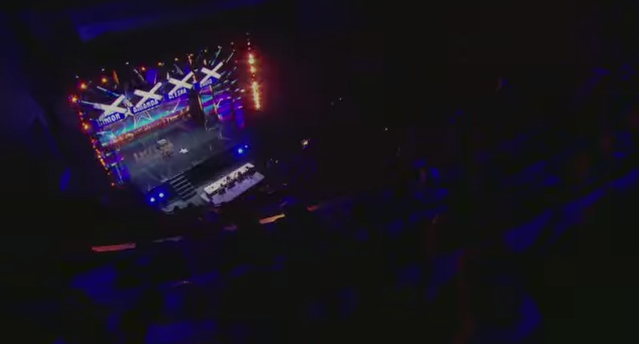 |
| Crane Shot of the audience as well as the crowd |
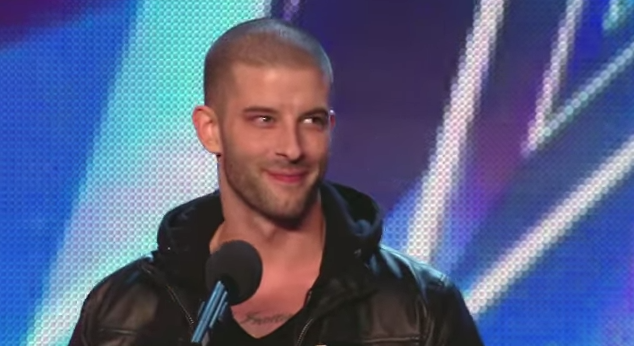 |
| Oake's expression |
At 0:09 we see a closeup of who the person is and how he look like. This is the introductory part of the performance where the performer introduces themselves and what they do for a living. With this close up shot we are able to clearly see on Television how the person looks like as if you was to sit in a crowd at the far back you will not be able to see clearly how the person looks like.
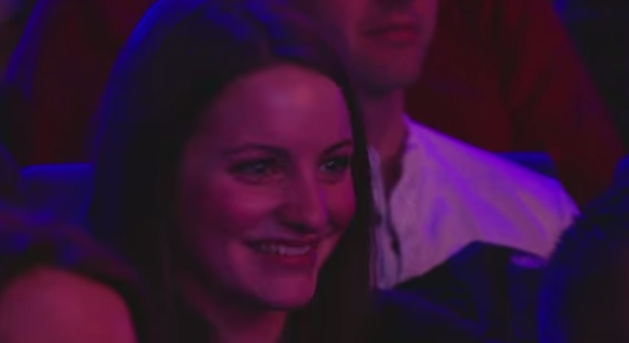 |
| Audience;s reaction to seeing him |
Straight after when we see the performer's face we are then directed back to the audience on their reaction on how they look like. Often it may be a relative but on Britain's Got Talent they are usually at the back with Ant & Dec. This close up of the audience allows the viewer at home to get a feel of how supportive the audience can be and see their facial expressions when they see the performance whether it is good or bad.
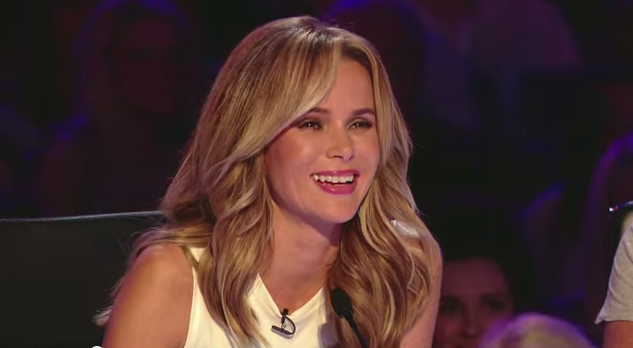
At 0:33 we see a shot of Amanda's face where she is laughing at Oake's parents insisting that he became a magician instead of his dreams of becoming a Doctor. With the Multi-Camera setup we are able to see each and every facial expression of the Judges. This can be a shocked facial expression, annoyed expression ect. The viewer at home is able to get this view because of Multi-Camera use. The audience behind will not be able to get the view of the Judge's face because they are directly behind them.
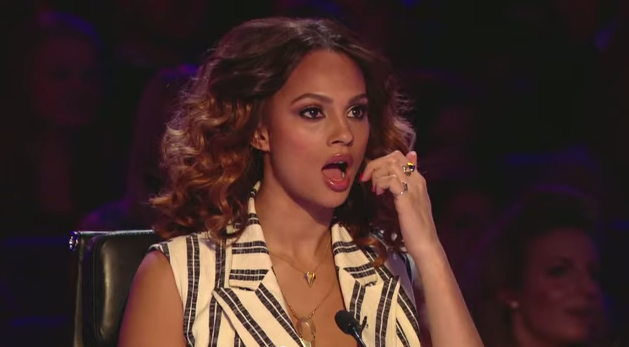
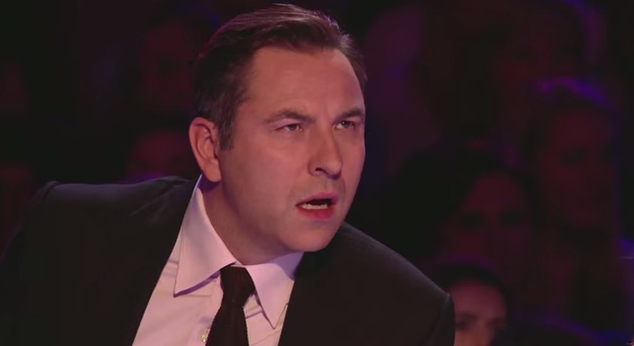
A very good example of the close up shot of the judges we get is at 1:44 where Alesha's jaw literally drops in seeing the Dove appear as an illusion. We can see clearly that she is completely blown away by the starting of the performance. This was only see-able by the viewers at home because the audience where behind her so they had no chance of seeing the initial reaction.
Here the Multi Camera not only helps the viewer see what is going on in the show but it is there for aesthetic reasons as well. The reason for this is because they want it to be visually appealing for the audience to watch instead of one boring shot which is still. It engages the viewer to keep watching the show and eventually pull them in so they do not leave. As the talent shows may have various talents the Multi-Camera setup allows all of that to be captures in angles not view able by the audience making it a better experience for the viewers.
Magazine Shows:
Magazine shows usually use Multi Cameras to capture the whole event. Straight after the Intro we are greeted by the presented via a Mid shot at 0:19. This invites the audience to watch the Magazine Show and pulls them more towards the Television. We are also seeing the two main hosts of the show. This allows the viewer to feel more comfortable knowing that the show is going to have an atmosphere where the mood is enjoyable and calm.
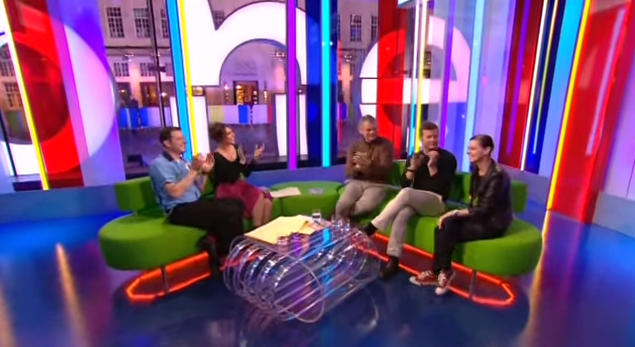
At 5:37 we are able to see the shot of the studio itself with a mini crane camera which is manually being operated by a cameraman. Thsi shows the viewer a full view of how the setup looks of the studio and who is there with the two main hosts of the show itself. The full shot gets all of the action into one frame which allows the viewer to see what is going on and who is there with the hosts. It also shows the mood of the Magazine Show as the facial expressions of the guests and the hosts are delighted to have them on the show ect.
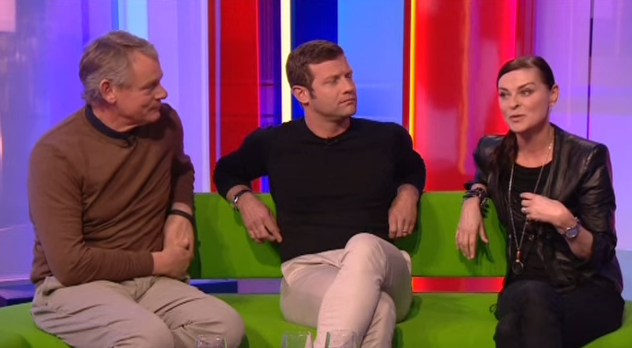
At 7:18 we are able to see a mid-shot of the guests of the show where she stalking about her movie as the role of the mother. We see that one camera is used to get facial expressions of the guests. The picture below shows the shot straight after the mid-shot of the guests where it shows a close up of Lisa Stansfield's facial expressions.
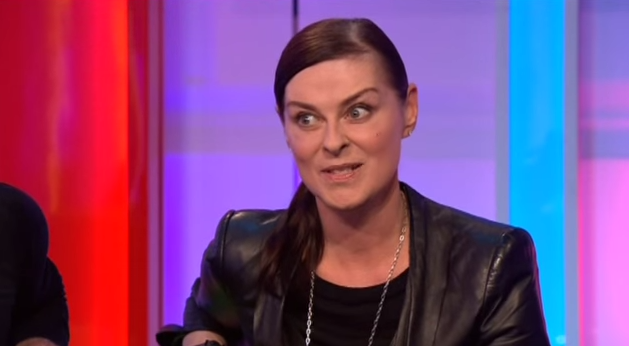
We see here the facial expressions of Lisa. This is done by the same camera that took the Midhsot view of the guests above. Here the setup has three cameras which one is pointing towards the Hosts, the other getting a full view of the conversation and the third getting the shot of the guests. These cameras are in near fixed positions and are able to move to keep the viewer more engaged instead of having shots where they are long. The shots cut at a decent pace as they do not want to bore the viewers.
Chat Shows:
A very good chat show would be the Alan Carr show. Here we have 3 cameras whoch are setup to capture the converastion between Nicki Minaj and Alan Carr himself. This has a similar setup to magazine shows but it usually has a different atmosphere to what we see on a agazine show.
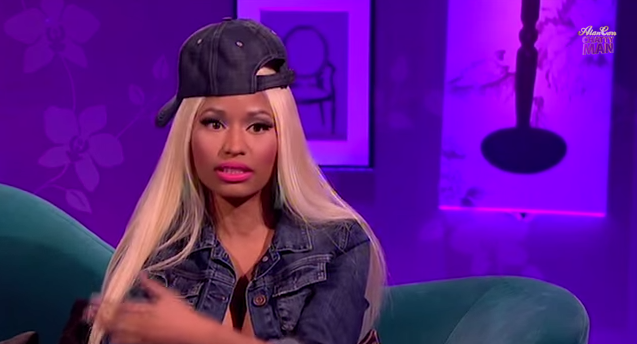
At 1:37 we see one of the cameras keeping a close up of Nicki's face to capture her reactions to seeing Alan Carr bringing the British Scones. The viewers at home are engaged straight away as it starts of with Nicki Minaj's reaction to seeing Alan Bringing the food over to the studio. This allows the audience to feel more comfortable with the atmosphere, which brings me onto my next point; Alan sets the mood of the show by bringing the food. The audience are laughing and the viewers at home are probably laughing as well due to his "Immature" side of him.
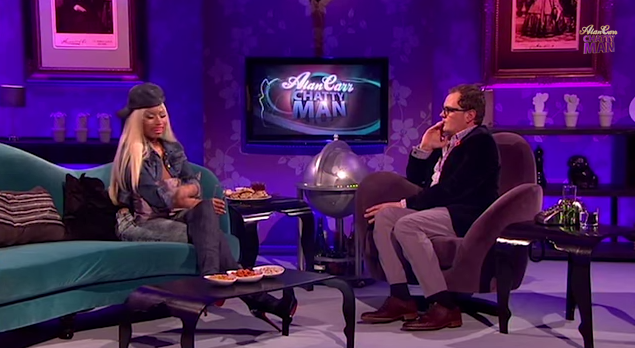
At 1:41 we see the Middle camera which captures both Nicki Minaj and Alan Carr. This shows the surroundings of them and how the tone is. The full shot of the two here is shown to the audience at home to show what the situation is like between the two; it shows the hand gestures, facial expressions in a way which the people can see in. Also with the use of Multi Cameras here we can see little details like why Alan Carr is sitting on the seat not the sofa, which all indicates he is the main host of the show ect.

Here we see the 3rd camera in action during the show at 2.18. We see Alan's reaction to Nicki Minaj "Doing what she did" during the show. We capture the moments where it has humour,. We can clearly see his facial expression of being shocked on camera and he is drinking his drink in amusement.
During magazine shows we are able to see the real side of people as in how they react how they are during shows when they are relaxed and in the mood., The aesthetic reasons for this show is that they want to keep the show at a steady pace with different angles they can switch between to keep the viewer engaged and without them leaving to watch another show.
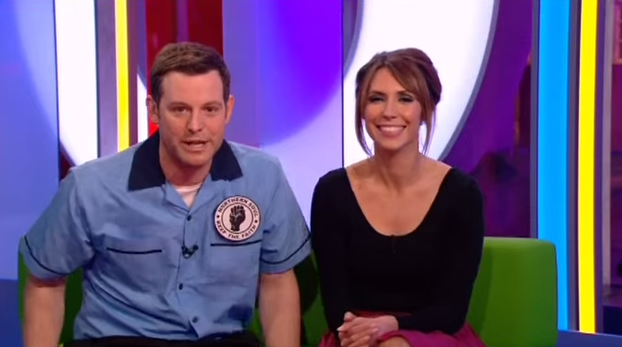
No comments:
Post a Comment